WOODS HOLE – When astronaut Sunita Williams was growing up in Needham, she wanted to be a veterinarian. “It didn’t come true,” she said, and then laughed. “I’m a failure,” she said.
Some failure.
This is the ultimate story of failing forward, all the way to space.
Williams has spent two extended stays aboard the International Space Station, and is preparing for a third trip there aboard one of the new commercial spacecraft being designed by Space X, and by Boeing.
Working for NASA, she speaks of the possibility of a space station being built on the moon or on Mars in the same matter-of-fact way someone working for a Cape Cod developer might speak of their company planning a hotel on Main Street.
Hers is the business of space exploration.
![]() ** Please support independent local journalism.
** Please support independent local journalism.
See the DONATION BUTTON AT THE TOP OF THE PAGE **![]()
When the R/V Neil Armstrong arrived for the first time in Woods Hole on April 6, Williams was one of the speakers welcoming the new research vessel of the Woods Hole Oceanographic Institution.
Touching elegantly on the theme of the blue marble, as Earth is often described by astronauts gazing back in wonder, Williams reminded the audience of the connection between space exploration and exploration of the world’s oceans.
“Cape Cod is where I come home to.” – astronaut Sunita Williams
It was a fitting theme for Williams, whose sister works for WHOI. Her sister and her parents live in Falmouth. “Cape Cod is where I come home to,” said Williams, who lives in Houston.
When Williams first moved to Houston, her colleagues at NASA spoke of going to the Cape, and Williams wondered why they were going to Cape Cod. It turns out, they were talking about Cape Canaveral. For Williams, Cape Cod remains in her heart.
“I got married in Woods Hole,” said Williams.
“When we were kids, that’s where we went. When you’re from Boston, you go to the Cape in the summer,” said Williams.
Not only is this astronaut familiar with Cape Cod, she has a long and very familiar relationship with water. She was a competitive swimmer in high school and college. And she is a self-described “Navy guy.”
So while the arrival of the R/V Neil Armstrong was a remarkable event, hearing Williams speak in front of a research vessel named after the most famous astronaut brought it all together.
All of the space shuttles are named after ships, she said, so it is only fitting that the new research ship would be named after an astronaut. And having spent two extended tours about the International Space Station (ISS), Williams drew the parallel between space and sea exploration.
“Like its shiny sister in space, the International Space Station,” Williams said at the R/V Neil Armstrong ceremony, “I’m sure (this ship and the scientists and crew aboard it) will make discoveries that will help save lives, open dialogs to solve societal issues, and strengthen international relations, spur on new, innovative business ideas, inspire the next generation of explorers, and perhaps even help sustain life on our lovely little speck of a planet in the universe.”
![]() In The Beginning, There Was Swimming
In The Beginning, There Was Swimming
Williams, the youngest of three children, was born in Euclid, Ohio and moved to Needham when she was 1.
“We were a pretty sporty family,” said Williams. “My mom is an awesome tennis player.”
Her father, who was born in India, was a doctor who worked more than 30 years for the Veteran’s Administration.
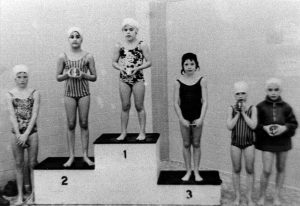
Sunita Williams as a young athlete, capturing second place. Photo courtesy of NASA and Sunita Williams
“My father almost drowned when he was a little kid,” she said. Because of that, her father insisted his children know how to swim. “I don’t even remember not knowing how to swim,” she said.
She played some soccer. “I had not bad foot-eye coordination,” she said. But swimming took up the majority of her efforts.
She swam competitive long distance in both high school and college. Before that, she was the captain of her club team.
Growing up and running in the farm fields of the undeveloped Needham of her youth, she loved animals and planned to go to school in Boston. “In my small, little brain, going to Harvard would get me on the road to veterinary school.”
Failure… small little brain… In more than three hours sprinkled over two phone interviews with Cape Cod Wave, Williams interspersed her story with these highly-endearing bursts of self-deprecating humor.
She did not get into Harvard, but she did receive a scholarship offer from Columbia. However, after visiting she decided the big city of New York was not for her. Instead, her brother, Jay Pandya, who was in the Navy suggested she apply to the Naval Academy.
It turned out to be a natural fit from the beginning when she did her first six weeks of indoctrination. “My swim team was a club team,” she said. “It was pretty rigorous, team oriented. When we went to meets, we went to win as a team. So it felt like a good fit when I got there. Anything in a service academy is all about the team.”
While those first six weeks can be physically challenging, Williams said, “It wasn’t overly stressful to me.” Again, it came back to swimming. One of her teams had trained and held home meets at Harvard. As part of training at Harvard, the team would run up and down “those horrible cement stadium steps,” she said.
Her physical transition to the Navy was smooth. But in school, “I had five A’s and two F’s at one point in time,” said Williams. “I had to change my major.”
She said she switched to general engineering and physical science, and then added, “I majored in graduation. I made my way through it. I swam, I ran cross country, and biked. I distracted myself quite a bit.”
![]() A Military Career Takes Flight
A Military Career Takes Flight
A cadet in the Naval Academy has a sponsor, an officer at the academy that guides the cadet to their next step. Williams’ sponsor was an experimental saturation diver. So she thought, “He was a swimmer and a diver. That’s what I want to be.”
But when it was her time to choose, the dive billet was gone. “At the time, ‘Top Gun’ had just come out. Aviation was cool. F-14s were cool,” she said.
Her 20/20 vision qualified her, so she decided on flight school and was accepted to study in Pensacola, Florida, “the cradle of Naval Aviation,” said Williams.
She had a long wait for flight school, and during that time she went to scuba school where she received her Navy diving qualification.
And then she went to flight school. By that time, she had a choice of diving or flying, and “I was thinking the better, more fun life will be flying.”
“Everything is romanticized by jets,” said Williams. “Of course that’s what I wanted to do. Don’t forget how old I was. I was 21, 22 at the time. That was sort of the thing to do,” she said. “But I didn’t get jets. I was a helicopter pilot.”
She flew H46 Shinooks, “the big ones with two big rotors on top,” said Williams. These passengers could carry passengers, mail and cargo, and came equipped with an external hook used for “vertical replenishment,” meaning the helicopter could pick up anything “from eggs to bombs” and move it between aircraft carriers.
“It’s cool, it’s really fun,” said Williams.
She joined the military in a time of peace. In August of 1991, Saddam Hussein invaded Kuwait. She was on a ship in the Mediterranean.
“It’s sort of funny, kind of like a switch turned. We were going from port to port – France, Spain, nice food, all relaxing to all of a sudden battle groups pulling through the Mediterranean and we’re up all night,” recalled Williams.
“The war paint came out, which was a little bit shocking but it made people have a a purpose for our job. It made more of a team for the whole military.”
One year later, Hurricane Andrew hit Miami, giving justification to “one of the whole reasons I wanted to be a helicopter pilot,” said Williams. She was in the office of helicopter detachment bringing supplies, food and water, to neighborhoods. “We would take multiple runs. We were landing in baseball fields, stuff like that,” she said.
After flying three different aircraft in one day at test pilot school, “I went home at night and had a beer and thought, that was a pretty cool day.” – Sunita Williams
She had the leadership responsibility of getting people to pull together. “It’s terribly rewarding,” she said.
While the work was rewarding, a constant theme in her journey has been the quest to learn more. She liked working with maintenance and working on engines, so she applied to be a test pilot to learn more about how safety procedures are developed. She also had a chance to learn about many types of aircraft.
She was a helicopter pilot but “we all get to fly everything at some point in time,” she said. Williams has flown more than 30 aircraft. The three types of test pilots are jet pilots, helicopter pilots and prop pilots, she said.
“Helicopter guys, we fly some six wings and some helicopters,” she said.
“Flying three different airplanes in a day, it’s pretty amazing,” she said, of being a test pilot. She flew “everything from the bare bones basic all the way up to an F18,” said Williams. “Then I went home at night and had a beer and thought, that was a pretty cool day.”
And then “when I was part of the test pilot school, we came down here to the Johnson Space Center… it was cool. We got to see all the simulators,” she said. While the first astronauts were all test pilots, Williams said applying to be an astronaut had never crossed her mind.
She had thought that astronauts were jet pilots. But then she learned how the moon trips required someone to fly vertical landing craft. “I didn’t even realize there were other helicopter pilots who were astronauts. So I started looking up the application.”
She applied, and then finished her two years of test pilot school. “I had to go back to sea. It’s called a disassociated sea tour. I would not be flying but still going back to sea. This is a way to get to appreciate the Navy.”
She landed an interview at the Johnson Space Center, and then went back out on the ship.
“Six months later, there was one phone in our department. One rotary phone. I was living on the ship and everyone had left when the phone rang. Are you interested in coming to Johnson Space Center to work in the astronaut program. It was seven at night in the office. I had a celebration by myself,” said Williams.
![]() Astronaut Training, And The Columbia Disaster
Astronaut Training, And The Columbia Disaster
“When you get here, training to fly is always a couple of years,” she said. “After that, it’s sort of like a waiting game…. The reality of actually going into space, people don’t actually think it’s going to happen until you are sitting on that rocket and those engines fire.”
She got into the program in 1998. Her first flight was in 2006.
Near the the end of November 2002, while waiting, she was attending the national outdoor leadership school in the underwater habitat near Key Largo. Again, it was back to the ocean. She had an opportunity to go to Antartica and collect meteorites.
About a week before she was to leave for Antarctica, she was asked, Do you want to go to the International Space Station?
“They were building the space station,” said Williams. “There were all sorts of space walks going on at the time.
She started training with a crew in 2003. On February 1, 2003, the Columbia Space Shuttle disintegrated as it re-entered Earth’s atmosphere, killing all seven crew members.
“The overwhelming emotion was disbelief. Secondly, we just lost seven friends.”
People needed to work with the families, she said, “and people needed to be working to figure out what happened, and when,” said Williams.
“The overwhelming emotion was disbelief. Secondly, we just lost seven friends.” – Sunita Williams on the moments after the Columbia disaster
And they did figure it out. “I’m pretty amazed by the talent and ability to pinpoint exactly what happened,” said Williams. On liftoff, said Williams, foam on the external tank fell off and hit the left wing, and made a hole in the wing. This hole caused the catastrophe on re-entry into the atmosphere.
NASA learned from what happened, made adjustments, and the mission continued.
But for two years NASA suspended all space shuttle flights to the ISS, which had been under construction since 1998. Only the smaller Russian Soyuz spacecraft was going there. Unlike the space shuttle, which carried seven people, the Soyuz only carried three.
“Everybody had their doubts at first whether we were really going to go back,” said Williams. But NASA found the cause and life went on, and they really were going back.
Construction of the ISS essentially stopped until the space shuttle started flying again. Williams, in space walks, would be working on the heating and cooling system.
“Our flight was the third flight after we started flying again after the accident.”
She understood the risk, and noted the challenge NASA has always faced.
“It’s space,” said Williams. “It’s pretty dynamic and fast. How do you plan for something you have no idea what to plan for?”
She said, of Earth compared to space, “It’s a 2-D world down here. If something bad happens in your car, you can pull over.”
![]() Preparing For Flight On The Space Shuttle, Discovery – 2006
Preparing For Flight On The Space Shuttle, Discovery – 2006
Astronauts have a training plan that marks progress as they prepare for launch. As they check things off on the training plan – x number of simulations etc. – they know they are getting closer to being ready, she said.
And beyond the physical and mental skills required, Williams noted the crew is carefully created. Beyond bringing people of varying skills – spacewalking, robotic arms etc. – to the space station, Williams said that a crew working in tight quarters obviously has to get along.
She leaned on her lessons from the National Outdoor Leadership School. “You learn that other people operate differently than you do. Learning what makes you happy, sad, pissed off, these are tools in your tool belt.”
In some ways, she said, a long space journey is similar to a military deployment. “Traveling around the world with that person, you get to know their family, what makes them tick. Most important is getting to know your crewmates. It makes or breaks that experience. It makes or breaks whether you are productive.”
And as the launch date approached, it was again like a military deployment, as she “squared things away with my family.”
In case something bad happens, she said, NASA has a plan in place, as Williams noted for the Columbia disaster, for someone to work with the families. “You pick someone that your spouse will get along with,” she said.
She “spent a week in Massachusetts” visiting her family, she said. “I think they were pretty psyched until we got to Florida. And then things started to get nerve-wracking for them.”
With 24 hours to go – L-24 hours – “you’re life becomes part of this L- time frame,” said Williams. Things are going on. The count starts, the clock is ticking… everything is choreographed.”
Her launch was at 11 PM. “Our wake up time was noon,” she said. “It was college hours, which was nice.”
She had to test out her suit, getting in it with the help of a “suit technician” and then there is a pressure check to be sure the suit holds pressure.
Her husband, brother, sister and parents were in town and they had dinner together, then after the protective structure around the Space Shuttle was removed, the family took a ride out to see it. “It was pretty spectacular,” she said.
All the time, the clock is “ticking, ticking, ticking closer,” said Williams
There are personal details to be taken care of, she said. “You figure out if your digestive system is working correctly… You go the bathroom one final time. Once in you are in your suit, you are wearing a diaper.”
As the astronauts are driven out the launchpad, Williams said, “It’s just sort of surreal. Wow, this is really going to happen. I’d been out to the launchpad before. But the spacecraft wasn’t filled with fuel.”
And seeing it like that, she said, “it seems like it’s alive. It’s plugged into a giant umbilical cord, getting data from the control center.”
It was nighttime. It was raining. There is an elevator, a 195-foot tunnel, and then a white room where the astronauts put on parachutes. And then they climbed in the spacecraft.
“There is a process to close the hatch. Do a pressure check. This time frame allows for anyone who has an issue with their suit to deal with it,” she said.
She spoke of “the whole process of the computer taking over. It’s a pretty detailed process. We really aren’t that involved up until the very end.”
As the astronauts are driven out the launchpad, Williams said, “It’s just sort of surreal. Wow, this is really going to happen. I’d been out to the launchpad before. But the spacecraft wasn’t filled with fuel.”
“There are pretty complicated commands that are being sent. We are there to answer the phone.” There is more of course. “Inside the shuttle there are lots of switches. All of those switches should already be in configuration.” If something needs adjusting, an astronaut is there to adjust it.”
That was not Williams role. “I was essentially cargo they were dropping off at the space station,” she said.
She was on the main deck. “The two other guys on the main deck were also rookies.” They held their hands up in the air, a sort of thumbs up. “All three of us were screaming like we were on a roller coaster,” said Williams.
The first 30 seconds of acceleration, she could feel the G-forces crushing her. It was hard to breathe. She was warned of it. “At first you are like, oh, that’s what they were talking about. And then, it’s going to be over. It’s going to be over. It’s going to be okay.”
After the first minute and a half, she said, “the atmosphere is becoming thinner and we’re going faster and faster.”
In 7-1/2 minutes, they were in orbit, she said. “Everything becomes slow and floaty… Holy crap we’re here. Then you realize what floating is. You take your gloves off and they float. It’s funny, but weird.”
![]() The ISS, Spacewalking, Running, And Diplomacy
The ISS, Spacewalking, Running, And Diplomacy
The space shuttle is exactly that, a shuttle. “They dropped me off and took another guy back home,” said Williams.
“When you see that shuttle leave and fly away,” said Williams, “you’re stomach drops. Oh crap, they’re going to Earth. I’m here.” Again, she compared it to being on deployment. The feeling “was familiar to me, a Navy guy.”
Still, she said, it was emotional. “I’ll be honest. I cried a little bit. And then I went up and had dinner with the guys.” Her attitude after that brief moment of reflection was, “Now get to work, you chucklehead.”
There was a timeline to get on. “We had three spacewalks coming up for reconfiguring the heating and cooling system,” said Williams.
When she did her first spacewalk, “Honestly, I was not scared at first. It was nighttime. Everything is very well choreographed and planned. I knew exactly what I was doing,” she said.
“And then the sun came up,” she said.
The ISS orbits the earth every 92 minutes.
“Holy crap,” she thought. “We are flying across the planet and I am sitting here outside in my suit.” While in awe at the experience, “compartmentalization,” allowed her to continue her work, she said.
And then she crossed the sun, shining on the planet and on her and, she said, “you can actually see how fast you are going.”
Of course her job involved more than the spacewalks and the heating system.
The whole day was scheduled but she did get time in to train for and then participate in, while in space, the Boston Marathon. “I qualified for it and I didn’t want to waste my qualification,” said Williams. Running while floating, she said, is painful. “You have a harness pulling you down.”
As an astronaut, PR, such as talking to Cape Cod Wave, is part of the job. But a bigger part is the reach-out and education. “If you are doing public relations, you want to give a message,” she said.
“A lot of people do things with kids,” she said. She has worked plenty with children, and the running the marathon was “a good way to highlight that even astronauts have to work out.”
There is a three-person crew aboard the International Space Station, unless the Soyuz is docked to it. Since 2011, when NASA ended the Space Shuttle program, the Soyuz is the only way to get to and from the ISS.
The International Space Station has a representative name. It is an international project involving more than a dozen nations and some inspirational cooperation between the American and Russian governments.
When Williams went on the ISS for the first time in 2006, both the American Space Shuttle and the Russian Soyuz spacecraft had been shuttling astronauts to the ISS since 1998.
“The whole reason we have a space station is that we have an international space station,” she said. “These are countries that sometimes didn’t get along, trading engineering methodologies. There’s a huge diplomatic plus that comes out of this kind of work.”
“It’s not simple, it’s hard,” she said. Each country came with “a different set of principles and values and motivations, and were somehow able to put all that aside and build this laboratory.”
On the other hand, she said, “It’s not so hard when you are up in space. You are a team. You’ve got to help each other.” In some ways, the astronauts in the space station take on a healthy “us against them” mentality, said Williams.
“One good thing about being trapped in a can with someone, it forces you to be mature,” said said.
When Williams first arrived, she was on the ISS with another American astronaut, and a Russian astronaut. In April, a Soyuz arrived to bring the other two to Earth, and to drop off two different astronauts. They were both Russian. She thought, “I have some heavy responsibility here.”
She felt the responsibility with the two new Russian crew members to be something of a diplomat. Now, she refers to them as “like two of my brothers, the Soyuz guys.”
Her first flight was supposed to last six months. But when her scheduled return shuttle was hit by hail before its scheduled launch, her flight home was delayed. She stayed 195 days.
The shuttle that was originally scheduled to pick her up in April was supposed to deliver a solar array, she said. The solar array finally arrived in June. It was time to return to Earth.
“What people are worried about when you are in space a long time is that you are exposed to a lot of radiation,” she said.
Leaving the ISS was sad, she said. “You feel a little ownership of the space station. It’s like one of your kids. It’s sad to leave. Part of it is you don’t know if you are ever going to get the opportunity to come back.”
She had been told that, “It’s harder to come back than it is to go. Gravity weighs you down.”
The return home “hit me like a ton of bricks,” she said. “You can’t simulate gravity.”
In her mind, she had scoffed at the idea that returning to Earth would be difficult. “My impression when I was up in space was I didn’t believe I wouldn’t feel good when I came home,” said Williams.
But the return home actually “hit me like a ton of bricks,” she said. “You can’t simulate gravity.
“I threw up after I came home. People do,” said Williams. “Your balance system is off.”
She explained. “There’s fluid in your ears, under the influence of gravity. When you are in space, that stuff floats and your whole cognitive system changes. Your brain has to go, oh yeah, this is gravity.”
“For me, it was like two days,” said Williams. Knowing others had already been through it helped, she said. Stimulating muscles by walking, and picking her knees up while walking, also helped.
Still, she felt tired. She simply didn’t feel good.
Gravity has such control on our bodies that when you escape it, the body changes, said Williams. Coming back, the body has to adjust again.
“Little things like lifting up your head with your neck takes work. Your head feels heavy. The muscles (supporting the head) haven’t had anything to do for six months.”
“Eventually you get it back again,” said Williams. “Initially, it’s tough.”
“I’ve been here 18 years,” said Williams. “I’ve only gone up twice.”
Her second trip up to the ISS was aboard a Soyuz in 2012.
By then, construction of the space station had finished. “On the second mission, the bulk of the mission was science experiments,” she said.
During that 2012 mission, she did three spacewalks and performed a schedule of experiments for elementary schools, colleges, universities, companies and private investors. They did hundreds of experiments, all while maintaining the space station.
While everything is timelined, that timeline can change depending on what needs to be done to the space station. “The hardware needs some maintenance, care and love every now and then to make sure it’s working,” said Williams.
When she is not in space, she is the deputy chief of the commercial crew branch of the Astronaut Office. NASA is working with Space X and Boeing as those companies develop a commercial spacecraft to go to the ISS. Space X is expected to fly in 2017, and Boeing in 2018.
Williams is expected to be aboard one of them.
“I am in the cadre of the first four expected to fly in them,” she said. “Four of us were specifically selected.”
![]() Five Minutes Over Nobska Light
Five Minutes Over Nobska Light
“We have a ham radio on board. Sometimes we do ham radio sessions with groups of kids,” said Williams.
Well, “one kid on Cape Cod, on his own, built his own little radio station.”

Cape Cod, Martha’s Vineyard, and Nantucket as seen from the International Space Station. Photo by Sunita Williams.
Dominic Fucile, a young high school student, set up a call with Williams’ sister, Dina Pandya, and they went to Nobska Lighthouse.
Williams was happy to do it. “That’s why we do it,” she said. “To provide inspiration to the next generation.”
With the ISS flying overhead, they had a five-minute window to talk.
“For the kid, he was cool as a cucumber,” said Williams. “But from what I heard later, he was beside himself.”
Williams was sort of that way too. “It’s the coolest thing to know you are talking to someone standing at Nobska Light,” she said.
For more stories like this, please see Longform stories
![]() ** Please support independent local journalism.
** Please support independent local journalism.
See the DONATION BUTTON AT THE TOP OF THE PAGE **![]()
– Please like us on Facebook.
–PLEASE SEE You Can’t Sell Right Field, a novel from Cape Cod Wave about land for sale, a crooked developer, a softball team called, “The Townies,” and an election.
Based on the true story of a Cape Cod development.
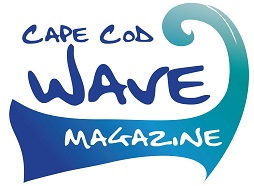

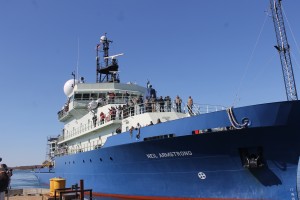

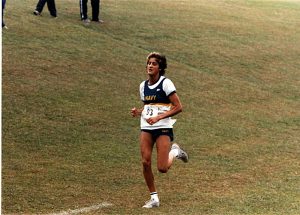

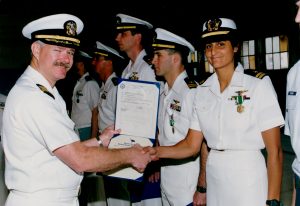
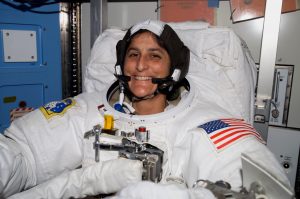
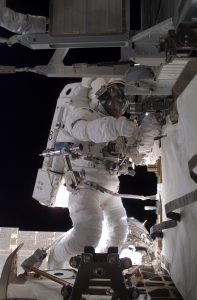








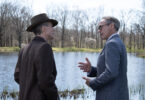


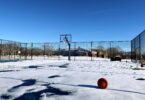
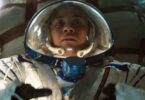




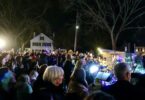

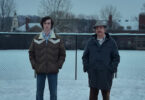
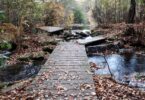

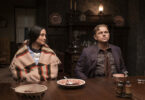
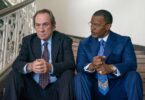
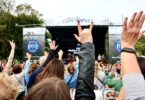

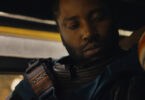
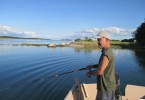

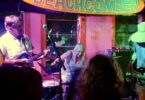
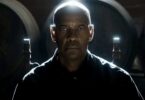
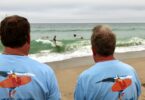
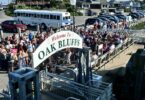
This is wondeful!
Great interview (and accompanying pix).